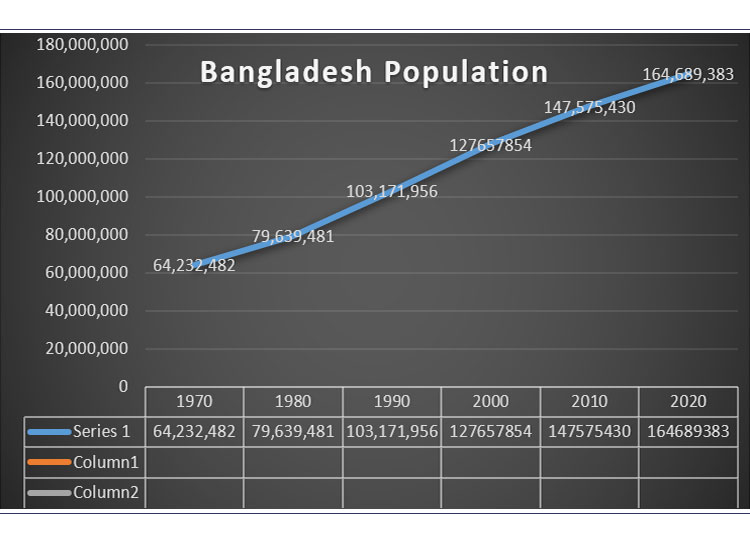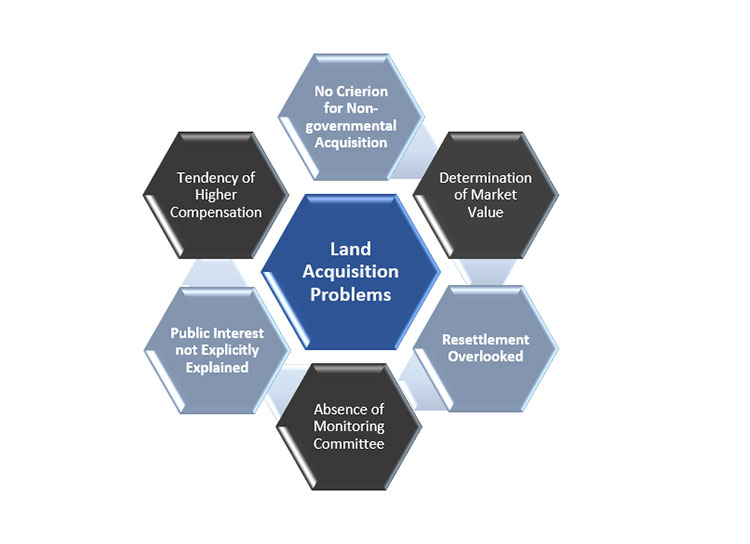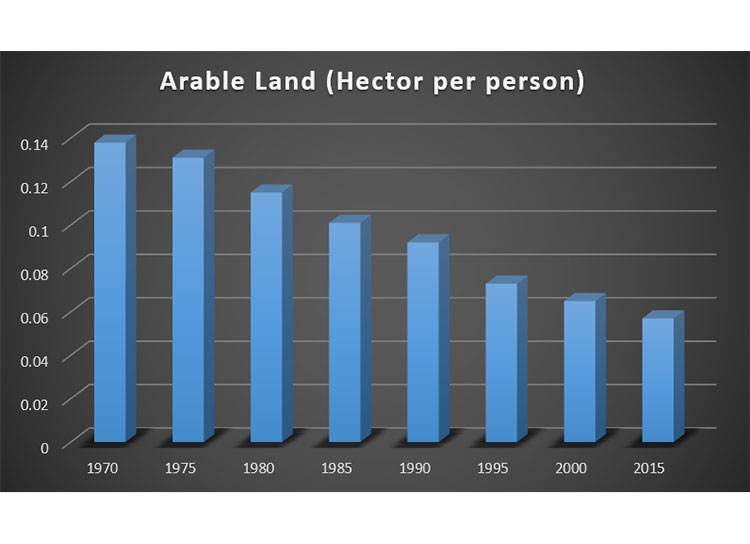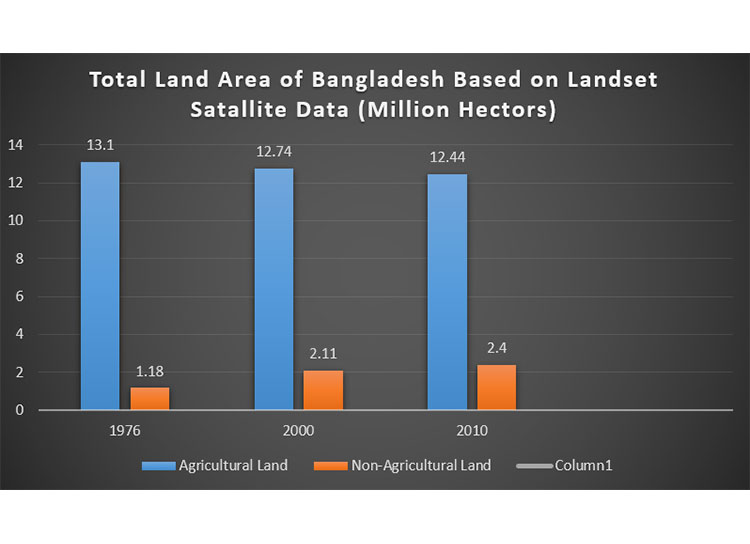Fatal Errors of Land Acquisition under Acquisition and Requisition Act, 2017

Fatal Errors of Land Acquisition under Acquisition and Requisition of Immovable Property Act, 2017:
Land acquisition by the state is a common procedure which is an issue for arising different opinions, conflicting viewpoints and many complications. This procedure refers to the meaning of land acquire by the government for special reasons. Bangladesh government has been taking many steps in order to develop the infrastructure of this country. Land is the main component to inaugurate these developments but in contrary Bangladesh, is a densely populated country. In fact, it is the eight most densely populated country in the world. So, most of the acquired lands are private property of the respected citizens. According to the survey conducted by Worldometer the current population rate from (1970-2020) are shown below:

Figure 1: Bangladesh Population
From the graph it can be observed that how abnormally the population growth increased between the (1970-2020) periods.
But Bangladesh does not consist enough land in comparison to its huge population. It is a small country of 148,460 square kilometers. So, acquisition of land results in distress for the private property owners most of the time. According to section: 2(1) of the Acquisition and Requisition of Immovable Property Act, 2017,
“Acquisition means acquiring the ownership and possession of any immovable property for any requiring person or organization in exchange for compensation or rehabilitation or both.”
The problems and Solutions regarding land acquisition are elaborately discussed below:
The Land Acquisition and Requisition of Immovable Property, 2017 replaced the 1982 ordinance in order to overcome the shortcomings of it but unfortunately it can be termed as a failure based on the view of many aspects. The act surely is repeating the previous flaws.

Figure 2: Land Acquisition Problems
No Criterion for Non-governmental Acquisition:
In Section: 4(2) of the Acquisition and Requisition of Immovable Property Act, 2017 it is stated that,
“In case of acquisition of immovable property for any non-governmental person or organization, whatever be the amount of the immovable property, sanction of the government must be taken before the initiation of acquisition proceeding.”
Here though it is stated to take sanction from government for acquisition, but there is no provision which states the amount of the land for particular purpose. A criteria should be set for every project taken by the non-governmental acquisition because the private property of the general citizens are already limited. If they are deprived of their property in absence of extreme necessity, it will result in infringement of their fundamental rights. The following graph is given in order to prove the insufficiency of arable lands. This is direct example of how small amount of land is there to support the large number of citizen of this country:

Figure 3: Arable Land in Bangladesh
From the above graph it can be clearly observed that within 1970 to 2015, arable land per person decreased in an alarming rate. If unnecessary amount land acquisition take place, the general people will face difficulties beyond description. As another example, we can enlighten on the project Elenga-Hatikamrul-Rangpur highway, (Sultana) which is a part of the Asian highway. This four lane project, according to the officials, the Road and Highways Department have to acquire 491.5 acres land to widen only 190.4 kilometer of a highway, which is rather shocking.
Tendency of Higher Compensation than Actual Level:
It is stated in Section: 9(2) of the Acquisition and Requisition of Immovable Property, 2017:
“While the government is acquiring land, it shall provide the person interested with compensation of 200 per centum of the market price….provided that, if the government acquires the land for any non-government person then the amount of the compensation shall be 300 per centum.”
As mentioned in the Act, the compensation rate for non-governmental acquisition is higher than the actual level. For this very reason, many projects are postponed before conduction, as in most of the cases, compensation cost is nearly higher than the actual project cost.
A project regarding building a connecting road in Lakhsmipur district in 2018, was cancelled by the Ministry of Road Transport and Bridges as the most of the estimated budget for the project, would have been expensed for the compensation payment purpose only. Amongst the 3.23 Billion budget, 3.07 billion was held as the compensation money for acquisition.
These obstacle has made complications regarding the development projects.
Solution: The Acquisition and Requisition Act should be amended in order to burden free the development projects by lowering the compensation rate, considering the circumstances.
Public Interests not explicitly mentioned:
According to Section: 4(1) of the Acquisition and Requisition of Immovable Property, 2017:
“Whenever it appears to the Deputy Commissioner that any property in any locality is needed or is likely needed for any public purpose or in the public interest, he shall cause a notice to be published at convenient places on or near the property in the prescribed form …..”
The above mentioned section clearly mentioned the word ‘public purpose’ but does not mention that what issues will be deemed as public purpose. For this reason, this section became so vague and flexible that in particular cases, there prevails a doubt whether the purpose of acquisition is really a public purpose or not. From the case Berman vs Parker (1954) 348 U.S. 26 [1954] it was observed that.
The plaintiff owned a department store that was not itself blighted but was scheduled to be acquired by the state in order clear the whole blighted area. There was an argument on the plaintiff’s side that only for the reason to make the community more attractive, the property cannot be acquired for the project managed by a private agency to redevelop the area.
In another case, Lila Ram v. Union of India [1975] AIR SC 697
The Orissa High Court held in this case that, there is no public purpose where property is taken is for industrial concern which is working solely for its own gain, though the goods produced by them, may be of used for the general public. (Abu Bakar Siddique & Md. Azhar Uddin Bhuiyan)
There is clearly a confusion prevailing on the side of plaintiff about the context of public purpose. Though the case set a landmark decision on eminent domain, still public purpose issue arose argument.
The Acquisition and Requisition of Immovable Property Act, 2017 did not set the criteria on the issue. So, confusion and complication is likely to arise deciding the matters.
Solution: To avoid the complications a well formed discussion and criteria for public purpose should be mentioned in the act.
Determination of Market Value:
Market value means the estimated amount for which an asset or liability should exchange on the valuation date regarding a transaction taking place between a willing buyer and seller.
According to Section: 9(1),
“In determining the amount of compensation to be awarded for any property to be acquired under this Part, the Deputy Commissioner shall take into consideration:
(a) the market value of the property at the date of publication of the notice under section: 4…”
The variability of land prices are large. So, market value may vary on many conditions. But there are no directions regarding determination of market value, where the private owner’s sole interest lies. There is a possibility that the correct market value might not be determined and as a result the private property owners will be deprived of the proper remedy.
In free market economy, the value of agricultural lands are determined without taking consideration of the productivity of the land or its importance with respect to what comes after. As a result when the average market value is being determined there is possibility of under valuing the property, though there are later provision to value the loss of crops and timbers.
Solution: Proper instructions must be enacted to determine the market value of the property taking consideration of its productivity and future prosperity.
No Significant Restrictions on Acquiring Agricultural and Cultivated Land:
The amount of agricultural lands are decreasing in an enormous rate due to the promiscuous use of these lands for infrastructural development, housing, industrialization etc. Acquisition of agricultural land for non-agricultural purpose is a huge cause behind the alarming decrease. Farmers face a lot of difficulties due to acquisition of their lands.

Figure 4: Total Land Area of Bangladesh
The above mentioned graph (Ahammad), shows that how drastically the amount of agricultural lands resulted in decrement between the years (1976-2010). Whereas the amount of non-agricultural land increased in number as a result of rural settlement and infrastructural development.
According to (section: 4), the Deputy Commissioner can send notice of acquisition if it is likely to be needed for public purpose. And in case of non-governmental acquisition, whatever the amount of immovable property may be, they can acquire the land after taking sanction from government. There is no restrictions set on the amount of agricultural land on the projects. As Bangladesh’s economy mainly depends on agriculture, shrinking the amount of agricultural land will be a great loss for the country.
In 2010, an agreement was signed between the Bangladesh Power Development Board and National Thermal Power Company Ltd in order to construct Rampal coal-fired plant in the Bagerhat District. For this construction plan, around 1834 acres of land was acquired by the government for this purpose. Most of these lands were used for shrimp cultivation.
Needless to say the resettlement of these shrimp cultivation resulted in great loss for the cultivators.
Solution: For non-governmental acquisition and also governmental acquisition restriction should be made on what amount of agricultural and cultivated lands can be acquired. Amount of land may vary per project.
Absence of Monitoring Committee:
In the Acquisition and Requisition Act, 2017 there is no provision regarding any special committee which will thoroughly monitor the whole procedure of acquisition. In this Act, it is stated in section: 4, that Deputy Commissioner can send notice of land acquisition if he thinks it is needed for public purpose. A sovereign power has been handed over to him, which is likely to be exploited in future. The establishment of monitoring team would have put a stop on the possibility of the power exploitation by the higher authority.
Solution: It is really important to establish a committee consisting experts, who will give the decision after Deputy Commissioners proposal of acquisition, whether the land is actually needed to be acquired or not, if it is necessary then exactly what amount should be acquired. After that, the government’s decision should have been held final. As the court held in “Chairman Bangladesh Steel Mills Corporation vs Masood Reza [1978] 30 DLR (AD) 169”
“Property of a citizen can neither be acquired nor be retained by the government unless it is done under proper legislative authorization. A citizen’s property cannot be seized also under colorable exercise of power conferred by the legislature”.
This decision clearly proves the importance of proper authorization. If the authority relating in charge of acquisition are well formed with experts, acquisition of land would be more reasonable and strict observation shall be possible conducted in order to deter unnecessary amount of land acquisition.
Short Time Limit to File an Objection:
According to section: 5(1) of the Act, “Any person concerned may file an objection against the acquisition proceeding to the Deputy Commissioner within 15 days.”
The time limitation set for filing objection is really insufficient for an ignorant citizen or people from the rural country as they do not know the procedure to file objection, when their rights are infringed. As the citizens are not aware of these procedures, they do need more time to know about the remedy they can seek from the authority.
Solution: Time limitation time for filing objection should be taken in consideration by the government. So that the sufferer get sufficient time to complain about their property problems if they feel necessary.
No Provision Regarding Taxation on Compensation Money:
There’s no provision in the Act indicating the income tax value on the basis of compensation money. As a result income tax rate on these compensation money are increasing rapidly. In the proposed Finance Bill-2020 (Financial Express) the rate of Advance Income Tax has been increased from 2.0 percent to 6.0 percent, if the property is held in city-corporation, municipality or cantonment board. And for the rural area the tax rate was raised from 1.0 percent to 3.0 percent. This will affect the poor citizens a great loss if they have to cut down that much compensation money in order to give tax.
Solution: Government should impose a limitation on increase of taxation on the compensation money. The sufferer will face much more difficulties if they do not receive the proper remedy. Amendment should be made in order make a provision regarding tax on the compensation.
Re-settlement Process Overlooked:
The idea of re-settlement of the people who has been removed from their land as a consequence of acquisition, has been completely overlooked in the Acquisition and Requisition of Immovable Property, 2017.
Previously in 1961 (Atahar), one of the most significant project, “Kaptai Hydrolic Dam Project” took place in Bangladesh. For this project, around 54,000 acres of land was acquired by the government and around 100,000 of the native tribes were evicted from their home. But the government took no step to rehabilitate these poor people.
Though such misery should have been come to an end by this new act, but unfortunately it didn’t bring any light on it. The citizens who are the sufferer of such removal face a lot of difficulties resettling, as the process is not easy at all. Especially who were evicted from their homestead land have to relocate to a new place, they have to move their lifelong saved belongings in a very short period of time. The act completely ignored the resettlement and relocation of these helpless folks.
Solution: Resettlement should be introduced in this act, in order to redress the sufferers properly. Also, transitional facilities should be provided to the sufferers.
In the constitution of Bangladesh, Article: 42(1): the right to enjoy private property has been established as a fundamental right for the citizen. But it is also stated that,
“A law made under clause (1) of this article shall provide for the acquisition, nationalization or requisition with compensation and shall fix the amount of compensation…”
The government has given right to its citizens to enjoy their property but they also ensured very clearly on the constitution that, the state have the absolute right to acquire any land they think fit. There is no scope to demand land acquisition illegal, but some changes can be made regarding its procedure, in order to avoid complications and public chaos.
References:
[1] ‘Bangladesh Population’, Worldometer, < https://www.worldometers.info/world-population/bangladesh-population/#:~:text=Bangladesh%202020%20population%20is%20estimated, (and%20dependencies) %20by%20population.> Accessed on January 4, 2021
- Bangladesh, Wikipedia.< https://en.wikipedia.org/wiki/Bangladesh> accessed on January 6, 2021
3.‘Arable Land (Hectars Per Person)- Bangladesh’, The World Bank,
<https://data.worldbank.org/indicator/AG.LND.ARBL.HA.PC?locations=BD>
accessed on 4th January 2021
4.Munima Sultana, ‘Land acquisition a new problem area for RHD’, (The Financial Express, June 12, 2018) <https://thefinancialexpress.com.bd/economy/bangladesh/land-acquisition-a-new-problem-area-for-rhd-1528606505>accessed on 6th January 6, 2021
- ‘Berman vs Parker’, (Wikipedia, 17th August 2020)< https://en.wikipedia.org/wiki/Berman_v._Parker> accessed January 6, 2021
- Priyanshu Gupta, ‘Determination of Market Value for Land Acquisition’, Manupatra <http://docs.manupatra.in/newsline/articles/Upload/42A8A66F-AAA2-48BF-BC7C-F33D34C59A52.pdf> accessed on January 7, 2021
- Saif Uddin Ahammad, ‘The Dynamics of Agricultural Land Management System in Bangladesh: The Challenges for Sustainable Development’, American Journal of Rural Development, Vol. 5, No. 1, (Science and Education Publishing, 2017) (5-18) < http://pubs.sciepub.com/ajrd/5/1/2/ > accessed January 7, 2021
- The Acquisition and Requisition of Immovable Property Act, 2017
- Muhammad Saifuddin Mahmud, Dik Roth, Jeroen Warner, ‘Rethinking “development”: Land dispossession for the Rampal power plant in Bangladesh’ Science Direct, (2020) <https://www.sciencedirect.com/science/article/pii/S0264837719309585> accessed on January 7, 2021.
- Abu Bakar Siddique & Md. Azhar Uddin Bhuiyan, ‘Preserving People’s Right to Property: Demystifying the Dichotomy of the term ‘Public Purpose’ in case of Acquisition and Requisition of Land’,
11.‘Tax raise on damages for acquired land likely’, The Financial Express (June 24, 2020)
https://thefinancialexpress.com.bd/economy/bangladesh/tax-raise-on-damages-for-acquired-land-likely-1592973151 accessed on January 7, 2021
12. Syed Al Atahar, ‘Development Project, Land Acquisition and Resettlement in Bangladesh; A Quest for Well Formulated National Resettlement and Rehabilitation Policy’, Vol. 3 No. 7; (International Journal of Humanities and Social Science, April 2013) <https://www.researchgate.net/publication/276268916_Development_Project_Land_Acquisition_and_Resettlement_in_Bangladesh_A_Quest_for_Well_Formulated_National_Resettlement_and_Rehabilitation_Policy >accessed on January 10, 2021

